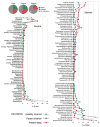The oral microbiome and the immunobiology of periodontal disease and caries
- PMID: 25447398
- PMCID: PMC4346134
- DOI: 10.1016/j.imlet.2014.08.017
The oral microbiome and the immunobiology of periodontal disease and caries
Abstract
The composition of the oral microbiome differs from one intraoral site to another, reflecting in part the host response and immune capacity at each site. By focusing on two major oral infections, periodontal disease and caries, new principles of disease emerge. Periodontal disease affects the soft tissues and bone that support the teeth. Caries is a unique infection of the dental hard tissues. The initiation of both diseases is marked by an increase in the complexity of the microbiome. In periodontitis, pathobionts and keystone pathogens such as Porphyromonas gingivalis appear in greater proportion than in health. As a keystone pathogen, P. gingivalis impairs host immune responses and appears necessary but not sufficient to cause periodontitis. Historically, dental caries had been causally linked to Streptococcus mutans. Contemporary microbiome studies now indicate that singular pathogens are not obvious in either caries or periodontitis. Both diseases appear to result from a perturbation among relatively minor constituents in local microbial communities resulting in dysbiosis. Emergent consortia of the minor members of the respective microbiomes act synergistically to stress the ability of the host to respond and protect. In periodontal disease, host protection first occurs at the level of innate gingival epithelial immunity. Secretory IgA antibody and other salivary antimicrobial systems also act against periodontopathic and cariogenic consortia. When the gingival immune response is impaired, periodontal tissue pathology results when matrix metalloproteinases are released from neutrophils and T cells mediate alveolar bone loss. In caries, several species are acidogenic and aciduric and appear to work synergistically to promote demineralization of the enamel and dentin. Whereas technically possible, particularly for caries, vaccines are unlikely to be commercialized in the near future because of the low morbidity of caries and periodontitis.
Keywords: Caries; Microbiome; Pathogenesis; Periodontitis.
Copyright © 2014. Published by Elsevier B.V.
Figures










References
-
- Liljemark WF, Bloomquist C. Human oral microbial ecology and dental caries and periodontal diseases. Critical reviews in oral biology and medicine : an official publication of the American Association of Oral Biologists. 1996;7:180–198. - PubMed
-
- Yang L, Chen T, Izard J, Tanner AC, Wade WG, Paster BJ, et al. The Human Oral Microbiome Database: Updates and New Features. Journal of dental research. 2014:93. - PubMed
Publication types
MeSH terms
Substances
Grants and funding
LinkOut - more resources
Full Text Sources
Other Literature Sources
Medical
Research Materials
Miscellaneous

